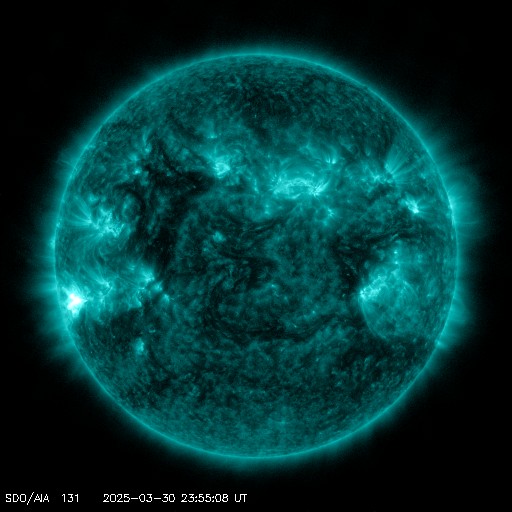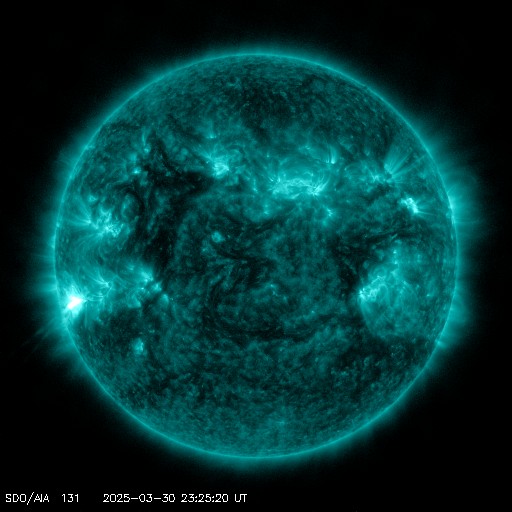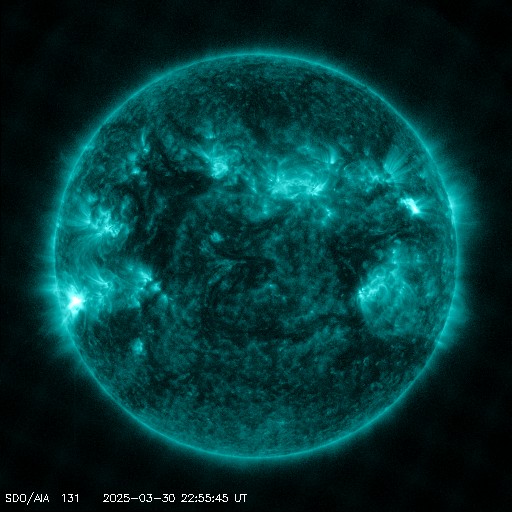Viewing archive of Wednesday, 23 March 2011
Solar activity report
Any mentioned solar flare in this report has a scaling factor applied by the Space Weather Prediction Center (SWPC). Because of the SWPC scaling factor, solar flares are reported as 42% smaller than for the science quality data. The scaling factor has been removed from our archived solar flare data to reflect the true physical units.
Report of Solar-Geophysical Activity 2011 Mar 23 2200 UTCPrepared by the NOAA © SWPC and processed by SpaceWeatherLive.com
Joint USAF/NOAA Report of Solar and Geophysical Activity
SDF Number 082 Issued at 2200Z on 23 Mar 2011IA. Analysis of Solar Active Regions and Activity from 22-2100Z to 23-2100Z
Solar activity increased to moderate levels. Region
1176 (S15E58) produced an isolated impulsive M1 flare at 23/0217Z
associated with weak radio emission. It also produced occasional B-
and C-class flares. Region 1176 rotated more fully into view and was
classified as an Eko-type group with a moderately complex beta-gamma
magnetic configuration. Region 1175 (N11W76) was quiet and stable as
it approached the west limb. New Region 1177 (N21E51) was numbered
as a magnetically simple, single-spot Axx-type.
IB. Solar Activity Forecast
Solar activity is expected to be at
mostly low levels during the period (24 - 26 March) with a chance
for an isolated M-class flare from Region 1176.
IIA. Geophysical Activity Summary 22-2100Z to 23-2100Z
Geomagnetic field activity was at quiet to unsettled levels, with a
brief interval of active levels detected at Boulder at around
23/0700Z. ACE solar wind data indicated the increased activity was
the result of a coronal hole high-speed stream. Solar wind
velocities gradually increased from 358 to 547 km/sec during the
period. IMF Bt increased during the period with a maximum of 11 nT
observed at 23/0714Z. IMF Bz was variable during the period and
ranged from -6 to +8 nT.
IIB. Geophysical Activity Forecast
Geomagnetic field activity is
expected to be at quiet to unsettled levels during days 1 - 2 (24 -
25 Mar) with a chance for brief active levels as coronal hole
effects persist. Activity is expected to decrease to quiet levels on
day 3 (26 March) as coronal hole effects subside.
III. Event Probabilities 24 Mar to 26 Mar
| Class M | 30% | 30% | 30% |
| Class X | 05% | 05% | 05% |
| Proton | 01% | 01% | 01% |
| PCAF | green | ||
IV. Penticton 10.7 cm Flux
Observed 23 Mar 105 Predicted 24 Mar-26 Mar 105/105/110 90 Day Mean 23 Mar 095
V. Geomagnetic A Indices
Observed Afr/Ap 22 Mar 005/006 Estimated Afr/Ap 23 Mar 008/008 Predicted Afr/Ap 24 Mar-26 Mar 008/008-008/008-005/005
VI. Geomagnetic Activity Probabilities 24 Mar to 26 Mar
| A. Middle Latitudes | |||
|---|---|---|---|
| Active | 15% | 15% | 10% |
| Minor storm | 05% | 05% | 01% |
| Major-severe storm | 01% | 01% | 01% |
| B. High Latitudes | |||
|---|---|---|---|
| Active | 20% | 20% | 15% |
| Minor storm | 10% | 10% | 01% |
| Major-severe storm | 01% | 01% | 01% |
All times in UTC
Current data suggests there is a slight possibility for aurora to appear at the following high latitude regions in the near future
Gillam, MB, Whitehorse, YT, Yellowknife, NTAnchorage, AK, Fairbanks, AK, Juneau, AK, Utqiagvik, AK
Latest news
Latest forum messages
Solar Demon 3Unspecified geomagnetic activity 2146AR4046 134Aurora photography hints for those of us with smartphones 54AR4048 34
More topicsSupport SpaceWeatherLive.com!
A lot of people come to SpaceWeatherLive to follow the Sun's activity or if there is aurora to be seen, but with more traffic comes higher server costs. Consider a donation if you enjoy SpaceWeatherLive so we can keep the website online!

Latest alerts
00:09 UTC - Solar flare
Moderate M1.03 flare
Sunday, 30 March 2025
23:51 UTC - Radio Blackout
Minor R1 radio blackout in progress (≥M1 - current: M1.03)
23:39 UTC - Solar flare
Moderate M1.52 flare
23:21 UTC - Radio Blackout
Minor R1 radio blackout in progress (≥M1 - current: M1.49)
23:09 UTC - Solar flare
Moderate M1.48 flare
Space weather facts
| Last X-flare | 2025/03/28 | X1.1 |
| Last M-flare | 2025/03/30 | M1.0 |
| Last geomagnetic storm | 2025/03/27 | Kp5 (G1) |
| Spotless days | |
|---|---|
| Last spotless day | 2022/06/08 |
| Monthly mean Sunspot Number | |
|---|---|
| February 2025 | 154.6 +17.6 |
| March 2025 | 127 -27.6 |
| Last 30 days | 127 -25.7 |





